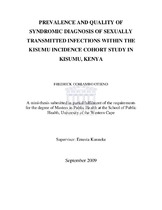| dc.description.abstract | Background: STIs are of major public health concern in developing countries, not least because they facilitate transmission of HIV, but also because they are important causes of mortality and morbidity among African populations, resulting in, among other things, adverse birth outcomes, neonatal and infant infections, ectopic pregnancy, anogenital cancer,infertility, pelvic inflammatory disease, and death. Thus, effective treatment needs to be prompt and accurate to control the spread, and morbidity and mortality of STIs. Even though syndromic approach to the management of STIs is effective, most evaluations have focused on syndromic STI management within STI clinics as opposed to research studies. Partner notification is an integral component of the syndromic approach and is aimed at preventing onward transmission of infection as well as re-infection. It includes
informing sexual partners of infected people of their exposure, administering presumptive treatment, and providing advice about the prevention of future infection.Methods: This is a cross sectional descriptive study based on a retrospective review of STI data of study participants in KICoS aged 18 to 34 years. A non probability convenience sampling method was used to recruit study participants. A total of 1,277 participants were prescreened into KICoS of whom 847 were enrolled into this study. Data was collected using CAPI and ACASI questionnaires as well as Teleforms which was analysed in SAS for windows 9.1.
Results: Syndromic prevalence of STIs was 5.7% while the aetiological prevalence was 32.8%.Risk factors to STI acquisition included, being female, having multiple sexual partners,having lower than tertiary education, using recreational drugs and being HIV. Agreement between the interviewing methods as well between the syndromic and laboratory diagnosis ranged from fair to substantial. This was also true for the agreement between laboratory and CAPI as well as between the laboratory and ACASI. Sensitivity was generally low while specificity was high. Uptake of contact tracing cards was high though with very low uptake of contact treatment with only 2.1% and 0.4% partners of the syndromically and aetiologically diagnosed participants coming for treatment.Conclusions: STI is a problem in this community and thus there should be more emphasis on risk reduction messages in patient education to mitigate the spread of STIs. The performance of syndromic management was very poor against the aetiological diagnosis thus there needs to further review the use of syndromic diagnosis of STIs in research settings.
Partner tracing needs to be intensified since there was very poor partner treatment even with high uptake of contact cards.Acknowledgements: This study would have not been what it was without the immense support I received from many individuals all of whom cannot be mentioned here. I would however want to thank
the Dr Wairimu Chege (Principal Investigator, KICoS) for her inspiration and
encouragement. I would also like to thank my supervisor, Ernie Kunneke for going
through this study with me repeated times including on a ride to the airport. On the same note I would also like to thank my lecturers and student administrators at the SOPH. My gratitude also goes to my colleagues Richard Ndivo, Sherri Pals and Eleanor McLellan-Lemal for all the support they accorded me throughout this research.I would also want to give my heartfelt gratitude to my family. My daughter Akinyi who used to type with me at night, her mother Auma for understanding my late nights up and finally to my Parents Mr and Mrs Gideon and Monica Otieno for understanding the importance of education and taking me to school through all the difficulties. Last but not least I would like to express my gratitude to the almighty God for having seen me through this process. | en_US |

